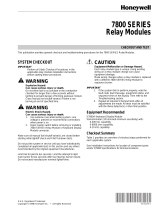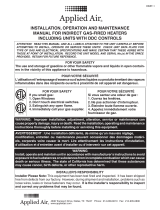Page is loading ...

SLATE
TM
Dual Flame Amplifier Support
Available in SLATE SW Rev. 3.10
Tech Features
Thermal Solutions

Dual Flame Amplifier Support Available in SLATE SW Rev. 3.10
Page 2 | 7
Introduction
In some applications involving long ribbon burners or applications where dissimilar flame sensing is required to insure the
integrity of the flame signal, multiple flame sensors are needed. Until now, SLATE supported a single flame amplifier per each
burner. With the release of SW 3.10, each SLATE burner module may support either a single amplifier or two amplifiers in any
combination. The two flame sensors may be set up in an “OR” configuration where only one sensor is required to sense flame
in order to keep the burner module satisfied (redundant configuration) or they may be set up in an “AND” configuration where
both sensors must have viable flame signals in order for the sequence to remain uninterrupted. They can be monitored
together or staggered in the burner sequence.
Redundant configurations (“OR”) can also be configured to only require one of two sensors to be functional. This may help
maintain the burners firing should one of the amplifiers fail.
So, on a long ribbon burner where both ends must be continuously monitored or those applications where different sensing
technology is needed to prove flame is present, the dual amplifier feature saves a lot of time and money.
The benefits of dual flame sensors/amplifiers extends to dual burner systems as well. Dual burners operating off a single main
gas line can be easily managed using a single burner module and two amplifier modules. When configured in an “AND”
configuration (S1 and S2), both burners must maintain flame signal in order for the burner module to avoid a lockout. Timing
configurations in the burner module allows staggering of flame sensing in a dual amplifier system.
Example: The burner module controls two igniters and a single pilot/main valve train. This dual burner option saves one
burner module as well as gas train components. It leverages SLATE’s ability to connect to two similar or different flame
sensors and monitor the two burners individually to either keep both burners firing or to lock out, shutting down both burners
on loss of flame from either burner.
The dual-amplifier approach requires burner module configuration to support the feature as well as an additional physical
setting on the amplifier module.

Dual Flame Amplifier Support Available in SLATE SW Rev. 3.10
Page 3 | 7
Amplifier Module Configuration:
Each amplifier module has a setting switch on the back indicating the amplifier’s position in a dual-amplifier application. The
default factory setting is “1”. The amplifier module which will occupy position two must be set to “2” using a small screw driver.
The setting switch is located on the back of the Amplifier Module.
Amplifier Module Position Setting Switch
Burner Module Configuration:
The dual-amplifier feature must also be configured in Niagara or in the generic pages. The configuration for multiple amplifier
modules is found in the burner module configuration. The flame sensing must work in an “AND” configuration when BOTH
amplifiers must read flame signals in order for both burners to fire. When flame signal redundancy is needed and two different
sensors are required, the configuration is set to “OR” and both flame sensors must lose the flame signal for the burner module
to lock out and the burners to stop firing.
Example:
In the configuration example below, two flame amplifiers are set up for a dual burner application. If either amplifier loses its
signal at any time, the burner module must lock out.
The amplifier modules must function in an “AND” configuration with a 10 second maximum allowable delay between the first
amplifier module flame detection and the second amplifier module flame detection in case the gas piping to the second
burner pilot/main burner nozzle is farther from the source than the first burner pilot/main burner nozzle and may require a
little more time to light off. Both scanners must be able to detect both the pilot and the main flames.

Dual Flame Amplifier Support Available in SLATE SW Rev. 3.10
Page 4 | 7
Ignition: S1 Run:S2-Sensor 1 is used only during Ignition while Sensor 2 is used in Run
Ignition: S1 Run: Combined S1 S2-Sensor 1 is used during Ignition while both Sensor 1 and Sensor 2 are used during Run in
an “AND” or an “OR” configuration to be defined in another parameter.
Combined S1 S2-Detection is done using both flame sensors during Ignition and Run in an “AND” or an “OR” configuration to
be defined in another parameter.
For the requirement, the selection “Combined S1 S2” is made as both sensors are used during Ignition and Run.

Dual Flame Amplifier Support Available in SLATE SW Rev. 3.10
Page 5 | 7
Next, the timing is selected that will give the second burner an opportunity to light-off given the possible delays between
burners. This timing is in addition to the PFEP/MFEP. In this example, we added 10 seconds.
The next configuration selection is the “OR” or “AND” logic in which the amplifiers/sensors will function.
S1 OR S2-both required- This configuration is redundant in that either of the two sensors sensing flame is sufficient to
maintain the burner(s) firing. Both amplifier modules must be present on the bus at all times.
S1 OR S2-one required- This configuration is redundant in that either of the two sensors sensing flame is sufficient to
maintain the burner(s) firing. Only one amplifier module must be present on the bus at all times to keep the burner(s) firing.
This configuration allows for the automatic transition to a single flame sensor should an amplifier fail.
S1 AND S2- This configuration requires that both sensors sense flame at all times. If either sensor loses flame, the burner(s)
shut down.

Dual Flame Amplifier Support Available in SLATE SW Rev. 3.10
Page 6 | 7
In this configuration “AND” logic is required as both flame sensors must sense flame for the burners to keep firing. If either
flame is lost, both burners will stop firing.
Finally, the amplifier details must be selected. For each amplifier specify the type and the threshold setting. Notice the Flame
Failure Response Time

Dual Flame Amplifier Support Available in SLATE SW Rev. 3.10
Page 7 | 7
Honeywell makes no warranties or representations, expressed
or implied, regarding the information contained in this
document. While Honeywell believes the information herein is
accurate, such information is provided “as is” and any use of
this information by the recipient is at the recipient’s sole risk.
TF-17-001-ENG
November 2017
© 2017 Honeywell International Inc.
For More Information
The Honeywell Thermal Solutions family of
products includes Honeywell Combustion
Safety, Honeywell Combustion Service, Eclipse,
Exothermics, Hauck, Kromschröder and Maxon.
To learn more about our products, visit
www.ThermalSolutions.honeywell.com or contact
y
our Honeywell Sales Engineer.
Honeywell Process Solutions
1250 West Sam Houston Parkway South
Houston, TX 77042
Honeywell House, Skimped Hill Lane
Bracknell, Berkshire, England RG12 1EB UK
Building #1, 555 Huanke Road,
Zhangjiang Hi-Tech Industrial Park,
Pudong New Area, Shanghai 201203
www.honeywellprocess.com
/


